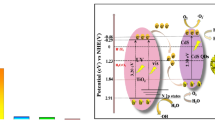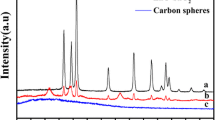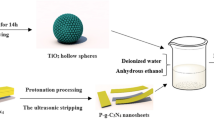Abstract
In this paper, a three-dimensional ordered hollow sphere (3DOH) structure composite Pt/TiO2-ZrO2 was prepared by using polystyrene (PS) colloidal spheres as the template and combining with two-step vacuum impregnation method, of which the composition, crystalline structure, morphology, and surface physicochemical properties were characterized by X-ray diffraction (XRD), UV-vis diffuse reflectance (UV-vis/DRS), photoluminescence (PL), X-ray photoelectron spectroscopy (XPS), scanning electron microscopy (SEM), high-resolution transmission electron microscopy (HRTEM), and nitrogen adsorption-desorption measurements. The results illustrate the crystal type of 3DOH Pt/TiO2-ZrO2 is mainly anatase TiO2 and tetragonal ZrO2 phase, which exhibits a three-dimensional ordered hollow sphere structure. Hollow spheres are arranged orderly; moreover, the composite shows a strong absorption in the visible region due to the effect of surface plasmon absorption (SPA) after doping Pt nanoparticles. Meanwhile, the photocatalytic activity of 3DOH Pt/TiO2-ZrO2 was investigated by using Congo red as the model molecule. The results show that 3DOH Pt/TiO2-ZrO2 has good photocatalytic activity under multi-modes photocatalytic experiments, and its activity is higher than that of P25, ZrO2, and other Pt/TiO2-ZrO2 not treated by PS colloidal spheres. In addition, the total amount of hydrogen production of 3DOH Pt/TiO2-ZrO2 is 100 times as much as the commercial P25 in the photocatalytic hydrogen evolution experiment (8 h), which shows an excellent photolysis of water hydrogen production activity.

The three-dimensional ordered hollow sphere composite 3DOH Pt/TiO2-ZrO2 was prepared by using polystyrene colloidal spheres (PS) as the template and combining with the two-step vacuum impregnation method, which had both good photocatalytic activity under multi-modes and ability on photocatalytic hydrogen evolution.












Similar content being viewed by others
References
Abdallah WA, Taylor SD (2008) Study of asphaltenes adsorption on metallic surface using XPS and TOF-SIMS. J Phys Chem C 112:18963–18972. https://doi.org/10.1021/jp804483t
An M, Li L, Tian Y, Yu H, Zhou Q (2018) The three-dimensional ordered macroporous structure of the Pt/TiO2-ZrO2 composite enhanced its photocatalytic performance for the photodegradation and photolysis of water. RSC Adv 8(34):18870–18879. https://doi.org/10.1039/C8RA00998H
Arandiyan H, Dai H, Deng J, Wang Y, Sun H, Xie S, Bai B, Liu Y, Ji K, Li J (2014) Three-dimensionally ordered macroporous La0.6Sr0.4MnO3 supported Ag nanoparticles for the combustion of methane. J Phys Chem C 118:14913–14928. https://doi.org/10.1021/jp502256t
Aw BH, Looh KK, Chan HSO, Tan KL, Hor TSA (1994) X-ray photoelectron spectroscopic characterization of [{Pt(PPh3)2(μ3-S)}2PtCl2], [{Pt2(PPh3)4(μ3-S)2Cu}2(μ-dppf)][PF6]2[dppf = Fe (C5H4PPh2)2] and other heterometallic aggregates derived from [{Pt(PPh3)2(μ-S)}2]. J Chem Soc Dalton Trans 1(21):3177–3182. https://doi.org/10.1039/DT9940003177
Bjijrneholm, Nilsson A, Tillborg H, Bennich P, Sandell A, Hernnk B, Puglia C, Martensson N (1994) Overlayer structure from adsorbate and substrate core level binding energy shifts: CO, CCH, and O on Pt (111). Surf Sci 315:983–989. https://doi.org/10.1016/0039-6028(94)90530-4
Cao T, Li Y, Wang C, Shao C, Liu Y (2011) A facile in situ hydrothermal method to SrTiO3/TiO2 nanofiber heterostructures with high photocatalytic activity. Langmuir 27(6):2946–2952. https://doi.org/10.1021/la104195v
Chen D, Wang Z, Ren T, Ding H, Yao W, Zong R, Zhu Y (2014) Influence of defects on the photocatalytic activity of ZnO. J Phys Chem C 118(28):15300–15307. https://doi.org/10.1021/jp5033349
Fu J, Wang J, Li Q, Kim DH, Knoll W (2010) 3D hierarchically ordered composite block copolymer hollow sphere arrays by solution wetting. Langmuir 26(14):12336–12341. https://doi.org/10.1021/la101625q
He S, Bi Y, Zhang Y (2015) One-pot synthesis and characterization of acid-catalyzed melamine formaldehyde/SiO2 aerogel via sol–gel technology. J Sol-Gel Sci Technol 74(1):175–180. https://doi.org/10.1007/s10971-014-3593-0
Joo JB, Zhang Q, Lee I, Dahl M, Zaera F, Yin Y (2012) Mesoporous anatase titania hollow nanostructures though silica-protected calcination. Adv Funct Mater 22(1):166–174. https://doi.org/10.1002/adfm.201101927
Legare P, Lindauer G, Hilaire L, Maire G, Ehrhardt J-J, Jupille J, Cassuto A, Guillot C, Lecante J (1988) On the interaction of O2 with Pt (111) and Pt (557) surfaces: core-level shift study using conventional and synchrotron radiation sources. Surf Sci 198:69–78. https://doi.org/10.1016/0039-6028(88)90472-4
Leidinger P, Popescu R, Gerthsen D, Feldmann C (2013) Nanoscale Ag2S hollow spheres and Ag2S nanodiscs assembled to three-dimensional nanoparticle superlattices. Chem Mater 25(21):4173–4180. https://doi.org/10.1021/cm401668g
Li Q, Chen W, Ju M, Liu L, Wang E (2011) ZnO-based hollow microspheres with mesoporous shells: polyoxometalate-assisted fabrication, growth mechanism and photocatalytic properties. J Solid State Chem 184(6):1373–1380. https://doi.org/10.1016/j.jssc.2011.04.006
Li L, Huang X, Hu T, Wang J, Zhang W, Zhang J (2014) Synthesis of three-dimensionally ordered macroporous composite Ag/Bi2O3-TiO2 by dual templates and its photocatalytic activities for degradation of organic pollutants under multiple modes. New J Chem 38:5293–5302. https://doi.org/10.1039/c4nj01002g
Li L, Huang X, Zhang J, Zhang W, Ma F, Xiao Z, Gai S, Wang D, Li N (2015) Multi-layer three-dimensionally ordered bismuth trioxide/titanium dioxide nanocomposite: synthesis and enhanced photocatalytic activity. J Colloid Interface Sci 443:13–22. https://doi.org/10.1016/j.jcis.2014.11.062
Liu J, Zhao Y, Shi L, Yuan S, Fang J, Wang Z, Zhang M (2011) Solvothermal synthesis of crystalline phase and shape controlled Sn4+-doped TiO2 nanocrystals: effects of reaction solvent. ACS Appl Mater Interfaces 3(4):1261–1268. https://doi.org/10.1021/am2000642
Nguyen CC, Vu NN, Do T-O (2015) Recent advances in the development of sunlight-driven hollow structure photocatalysts and their applications. J Mater Chem A 3(36):18345–18359. https://doi.org/10.1039/c5ta04326c
Pearson A, Bhargava SK, Bansal V (2011) UV-switchable polyoxometalate sandwiched between TiO2 and metal nanoparticles for enhanced visible and solar light photococatalysis. Langmuir 27:9245–9252. https://doi.org/10.1021/la201655n
Qi X, Li X, Chen B, Lu H, Wang L, He G (2016) Highly active nanoreactors: patchlike or thick Ni coating on Pt nanoparticles based on confined catalysis. ACS Appl Mater Interfaces 8(3):1922–1928. https://doi.org/10.1021/acsami.5b10083
Roy N, Park Y, Sohn Y, Leung KT, Pradhan D (2014) Green synthesis of anatase TiO2 nanocrystals with diverse shapes and their exposed facets-dependent photoredox activity. ACS Appl Mater Interfaces 6:16498–16507. https://doi.org/10.1021/am504084p
Samson K, Sliwa M, Socha RP, Góra-Marek K, Mucha D, Rutkowska-Zbik D, Paul JF, Ruggiero-Mikołajczyk M, Grabowski R, Słoczyński J (2014) Influence of ZrO2 structure and copper electronic state on activity of cu/ZrO2 catalysts in methanol synthesis from CO2. ACS Catal 4:3730–3741. https://doi.org/10.1021/cs500979c
Sasikala R, Shirole AR, Bharadwaj SR (2013) Enhanced photocatalytic hydrogen generation over ZrO2-TiO2-CdS hybrid structure. J Colloid Interface Sci 409:135–140. https://doi.org/10.1016/j.jcis.2013.07.047
Vaidya R, Simonson RJ, III J C, Dimos D, Lo’pez GP (1996) Formation and stability of self-assembled monolayers on thin films of lead zirconate titanate (PZT). Langmuir 12:2830–2836. https://doi.org/10.1021/la951072k
Wang D, Hisatomi T, Takata T (2013a) Core/shell photocatalyst with spatially separated co-catalysts for efficient reduction and oxidation of water. Angew Chem Int Ed Eng 52(43):11252–11256. https://doi.org/10.1002/chin.201404012
Wang Y, Wang Y, Xu R (2013b) Photochemical deposition of Pt on CdS for H2 evolution from water: markedly enhanced activity by controlling Pt reduction environment. J Phys Chem C 117:783–790. https://doi.org/10.1021/jp309603c
Wang J, Yu Y, Li S, Guo L, Wang E, Cao Y (2013c) Doping behavior of Zr4+ ions in Zr4+-doped TiO2 nanoparticles. J Phys Chem C 117(51):27120–27126. https://doi.org/10.1021/jp407662d
Wang X, Zhang Y, Hao C, Feng F, Yin H, Si N (2014) Solid-phase synthesis of mesoporous ZnO using lignin-amine template and its photocatalytic properties. Ind Eng Chem Res 53:6585–6592. https://doi.org/10.1021/ie404179f
Wang W, Zhu D, Shen Z, Peng J, Luo J, Liu X (2016) One-pot hydrothermal route to synthesize the Bi-doped anatase TiO2 hollow thin sheets with prior facet exposed for enhanced visible-light-driven photocatalytic activity. Ind Eng Chem Res 55(22):6373–6383. https://doi.org/10.1021/acs.iecr.6b00618
Waterhouse GIN, Metson JB, Idriss H, Sun-Waterhouse D (2008) Physical and optical properties of inverse opal CeO2 photonic crystals. Chem Mater 20:1183–1190. https://doi.org/10.1021/cm703005g
Xie H, Li Y, Jin S, Han J, Zhao X (2010) Facile fabrication of 3D-ordered macroporous nanocrystalline iron oxide films with highly efficient visible light induced photocatalytic activity. J Phys Chem C 114:9706–9712. https://doi.org/10.1021/jp102525y
Xiong J, Li Z, Chen J, Zhang S, Wang LZ, Dou SX (2014) Facile synthesis of highly efficient one-dimensional plasmonic photocatalysts through Ag@Cu2O core-shell hetero-nanowires. ACS Appl Mater Interfaces 6(18):15716–15725. https://doi.org/10.1021/am502516s
Xu Y, Schoonen MAAA (2000) The absolute energy positions of conduction and valence bands of selected semiconducting minerals. Am Mineral 85:543–556. https://doi.org/10.2138/am-2000-0416
Yang J, Wang D, Han H, Li C (2013) Roles of cocatalysts in photocatalysis and photoelectrocatalysis. Acc Chem Res 46(8):1900–1909. https://doi.org/10.1021/ar300227e
Yu C, Yang K, Xie Y, Fan Q, Yu J, Shu Q, Wang C (2013) Novel hollow Pt-ZnO nanocomposite microspheres with hierarchical structure and enhanced photocatalytic activity and stability. Nanoscale 5(5):2142–2151. https://doi.org/10.1039/C2NR33595F
Yu C, Yu B, Chen J, Zhou W, He H, Yu J, Zhu L, Xue S (2015) Pt/Bi2WO6 composite microflowers: high visible light photocatalytic performance and easy recycle. Sep Purif Technol 154:115–122. https://doi.org/10.1016/j.seppur.2015.09.034
Yu C, Zhou W, Hong L, Liu Y, Dionysiou D (2016a) Design and fabrication of microsphere photocatalysts for environmental purification and energy conversion. Chem Eng J 287:117–129. https://doi.org/10.1016/j.cej.2015.10.112
Yu C, Wei L, Zhou W, Dionysiou D, Zhu L, Shu Q, Liu H (2016b) A visible-light-driven core-shell like Ag2S@Ag2CO3 composite photocatalyst with high performance in pollutants degradation. Chemosphere 157:250–261. https://doi.org/10.1016/j.chemosphere.2016.05.021
Zhang LL, Li, Zhang J, Guo P, Zheng J, Zhao XS (2010) Enhancement of electrochemical performance of macroporous carbon by surface coating of polyaniline. Chem Mater 22(3):1195–1202. https://doi.org/10.1021/cm902685m
Zhang J, Wang Y, Zhang J, Lin Z, Huang F, Yu J (2013) Enhanced photocatalytic hydrogen production activities of Au-loaded ZnS flowers. ACS Appl Mater Interfaces 5:1031–1037. https://doi.org/10.1021/ar300227e
Zhang J, Li L, Liu D, Zhang J, Hao Y, Zhang W (2015) Multi-layer and open three-dimensionally ordered macroporous TiO2-ZrO2 composite: diversified design and the comparison of multiple mode photocatalytic performance. Mater Des 86:818–828. https://doi.org/10.1016/j.matdes.2015.07.166
Zhang J, Li L, Wang S, Huang T, Hao Y, Qi Y (2016a) Multi-mode photocatalytic degradation and photocatalytic hydrogen evolution of honeycomb-like three-dimensionally ordered macroporous composite Ag/ZrO2. RSC Adv 6:13991–14001. https://doi.org/10.1039/C5RA18964K
Zhang J, Li L, Xiao Z, Liu D, Wang S, Zhang J, Hao Y, Zhang W (2016b) Hollow sphere TiO2–ZrO2 prepared by self-assembly with polystyrene colloidal template for both photocatalytic degradation and H2 evolution from water splitting. ACS Sustain Chem Eng 4(4):2037–2046. https://doi.org/10.1021/acssuschemeng.5b01359
Zhong Y, Wang Z, Zhang R, Bai F, Wu H, Haddad R, Fan H (2014) Interfacial self-assembly driven formation of hierarchically structured nanocrystals with photocatalytic activity. ACS Nano 8(1):827–833. https://doi.org/10.1021/nn405492d
Zou S, Schatz GC (2004) Narrow plasmonic/photonic extinction and scattering line shapes for one and two dimensional silver nanoparticle arrays. J Chem Phys 121(24):12606–12612. https://doi.org/10.1063/1.1826036
Funding
This study is supported by the National Natural Science Foundation of China (21376126), the Fundamental Research Funds in Heilongjiang Provincial Universities, China (135209105), Government of Heilongjiang Province Postdoctoral Grants, China (LBH-Z11108), Postdoctoral Researchers in Heilongjiang Province of China Research Initiation Grant Project (LBH-Q13172), College Students’ Innovative Entrepreneurial Training Program Funded Projects of Qiqihar University, and Qiqihar University in 2016 College Students Academic Innovation Team Funded Projects.
Author information
Authors and Affiliations
Corresponding author
Ethics declarations
Conflict of interest
The authors declare that they have no conflict interest.
Additional information
Publisher’s note
Springer Nature remains neutral with regard to jurisdictional claims in published maps and institutional affiliations.
Electronic supplementary material
ESM 1
(DOC 1906 kb)
Rights and permissions
About this article
Cite this article
An, M., Li, L., Zhang, J. et al. Three-dimensional ordered hollow sphere composite Pt/TiO2-ZrO2: enhanced performance of photocatalytic degradation and photocatalytic hydrogen evolution. J Nanopart Res 21, 117 (2019). https://doi.org/10.1007/s11051-019-4564-8
Received:
Revised:
Accepted:
Published:
DOI: https://doi.org/10.1007/s11051-019-4564-8




